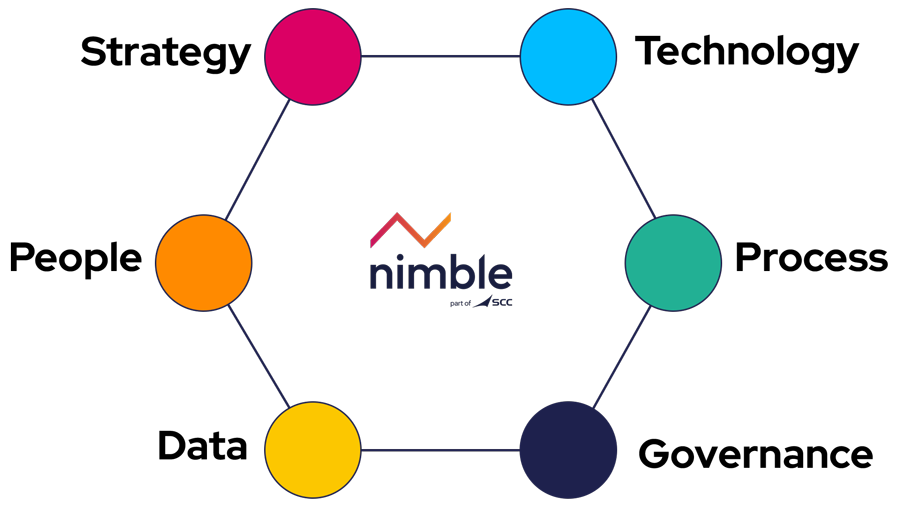
By Richard Louden, Head of Technology (Data) at Nimble Approach
This blog explores how organisations can assess their current level of data maturity, identify priority areas for improvement, and take practical steps to turn that maturity into measurable business value.
Data is now viewed as a key enabler for organisations and is being shown the same level of investment that software development saw in the early-to-mid 2000’s.
This shift is driven by data’s role across three core objectives:
- Understanding gaps in the organisation and/or market, in order to target growth or efficiency.
- Implementing change in order to target known areas for growth or efficiency. This is especially relevant given the current demand for AI solutions, and their need for high-quality organisational data to provide context.
- Measuring the impact of the delivered changes to understand return on investment.
Given that these are all critical objectives for any organisation, one might assume that most are highly mature in the data space and are in search of marginal gains.
However, this is sadly not the case due to a myriad of reasons – business pressure, budgets, skills gaps, technology estates, etc – in combination with the desire to chase technology as an all-encompassing solution.
Having a strong level of data maturity is about far more than owning a data platform or producing outputs. It requires a balanced focus across several interconnected areas – Strategy, Technology, People, Governance, Data, and Process – where progress in one supports and strengthens the others.
To drive meaningful improvement, organisations first need a shared understanding of their current level of data maturity, a clear view of where they want to be, and agreement on the priority areas to focus on.

How to Assess Your Data Maturity
The first step for an organisation looking to improve its data maturity is creating an honest, factual representation of how mature they are across a set of key areas.
Although some may view this process with concern, it represents a constructive and necessary first step toward meaningful progress.
The exercise can be complex, especially where maturity must be evaluated qualitatively rather than through traditional quantitative measures such as cost, delivery outputs, or return on investment. As such, setting out clear maturity criteria is key in order to support and align any assessment work.
Once criteria has been established, you can assess and document each area in order to designate a maturity level, determine suitable targets and gaps, and start planning improvements in priority areas.
This will involve several core activities such as reviewing strategic documents, interviewing staff to understand current skills, and assessing your technology estate and delivery processes. As mentioned above, the key to this process is honesty. There is no benefit in trying to pass off something as being more mature than it really is, and this will ultimately be exposed through the ongoing impact on data-driven value and performance.
When evaluating your organisation’s data maturity, it’s important to take a holistic view across several core areas, including asking questions like:
- Strategy
- Is there a data strategy?
- Is it available / known within the organisation?
- Does it align to the business / business unit strategies?
- Technology
- What technology is utilised?
- Is it maintained / updated?
- Does it have clear ownership?
- Does it allow us to meet our business objectives?
- People
- What skills and capacity do we have?
- How does this match to our technology stack?
- Do these skills match our future ambitions?
- Do we have Learning & Development processes in place?
- Processes
- How do we onboard new data?
- How are new data products requested?
- What are our release processes, are they efficient?
Putting it Into Action
Now that you have a benchmark for your data maturity, it’s easier to identify priority areas for improvement by considering where the greatest value can be gained and which initiatives will best support progress in those areas.
For example, the assessment might reveal lower maturity levels in areas such as data strategy and processes, which could be limiting the perceived value of your data outputs.
As such, a first step to address this would be trying to better align the data and business strategies and improving the process for working with end users to develop outputs. As a result, you would expect outputs to be better aligned to both the business and end users, hopefully improving their use and associated value.
Once a set of initiatives have been determined, prioritised, and roadmapped, including associated metrics to track their impact, they should be fed into existing delivery processes. Once the first tranche is implemented, a second assessment should be conducted in order to understand the organisation’s new level of data maturity and what lessons were learnt as part of this first phase. By taking this approach from the outset, the process can work as a continuous improvement loop, pushing the organisation’s data maturity further each time and delivering value in an incremental fashion. This is in contrast to treating it as a discrete project that is opened and then closed after the initial phase.

Key takeaways
Data is a key asset for driving growth and transformation, but unlocking its full value requires a strong level of data maturity. The journey begins with assessing your organisation’s current maturity based on clear, agreed criteria, which provides a foundation for identifying and prioritising initiatives to build capability. By implementing these initiatives and regularly reassessing progress in a continuous improvement cycle, organisations can enhance the value derived from both new and existing data assets, ensuring they effectively support key strategic objectives.
Nimble’s Data Maturity Assessment
If you are looking to improve the return on value from your data, but are struggling to understand your level of data maturity, Nimble Approach can support you.
Our rapid, 2-4 week, data maturity assessment enables a shorter time to value by quickly identifying where you are on your data journey and what to focus on next. Using an established set of maturity criteria across six key areas, we assess your organisation, pinpoint priority opportunities for improvement, and develop a clear roadmap of initiatives to accelerate progress.
By helping you move faster toward data maturity today, we set the foundation for long-term, sustainable value – empowering your organisation to make smarter decisions, innovate with confidence, and continue building stronger data capabilities for the future.









